Cheetahs are some of the most beautiful animals roaming the African savannah, and their adorable babies are full of interesting quirks that make them even more memorable.
Baby cheetahs are called cubs and weigh less than one pound at birth. These cute baby animals stay with their mother until they are about 18 months old and spend the time learning how to hunt and survive predators.
There’s a lot to learn about baby cheetahs, like how they have unique sounds like chirping and yelping.
Let’s look at 11 facts about baby cheetahs that will make you want to see one in person.
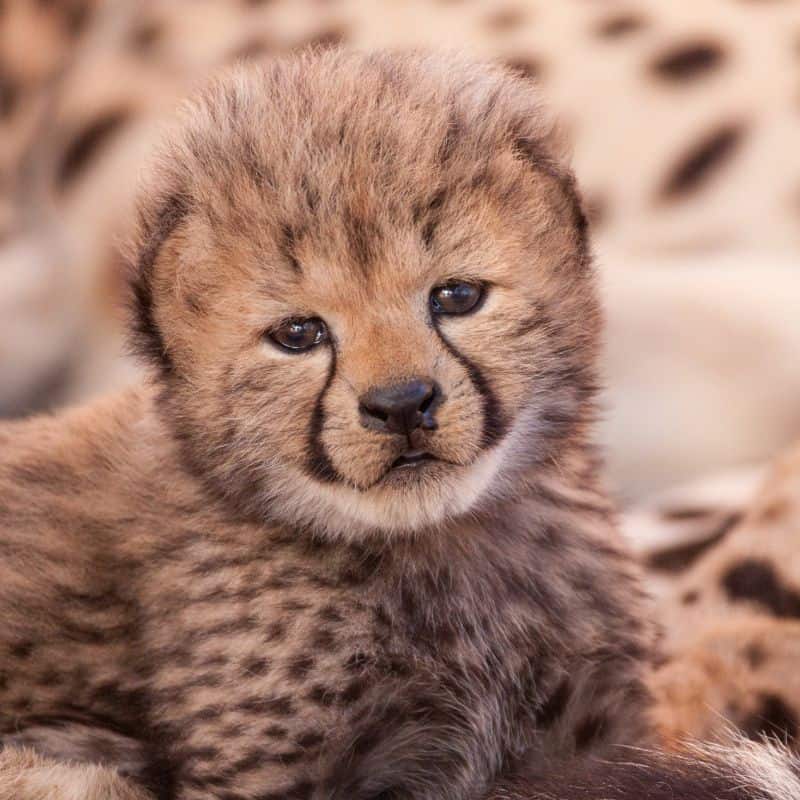
- 1. Baby cheetahs are called cubs
- 2. Cheetah cubs weigh less than 15 ounces
- 3. Cheetahs are born with 2500 spots
- 4. Baby cheetahs chirp and yelp
- 5. Cheetahs need two weeks to start walking
- 6. Baby cheetahs are very playful
- 7. Short gestation period
- 8. Cheetahs stay with their mother until adolescence
- 9. Cheetahs have between one and six cubs
- 10. Baby cheetahs are gradually introduced to meat
- 11. King cheetah cubs are extremely rare
- Final thoughts on the baby cheetah
1. Baby cheetahs are called cubs
A baby cheetah is called a cub, unlike house cats, which are called kittens. Unfortunately, cheetah cubs are endangered, so it’s best to leave these cubs alone if you happen to encounter one in the wild.
Here’s a breakdown of the life stages of cheetahs::
- Cub – Birth to 18 months
- Adolescence – 18-24 months
- Adult life – 24 months and up
Most wild cheetahs live between 10-12 years, with males usually living less due to territorial issues with other males.
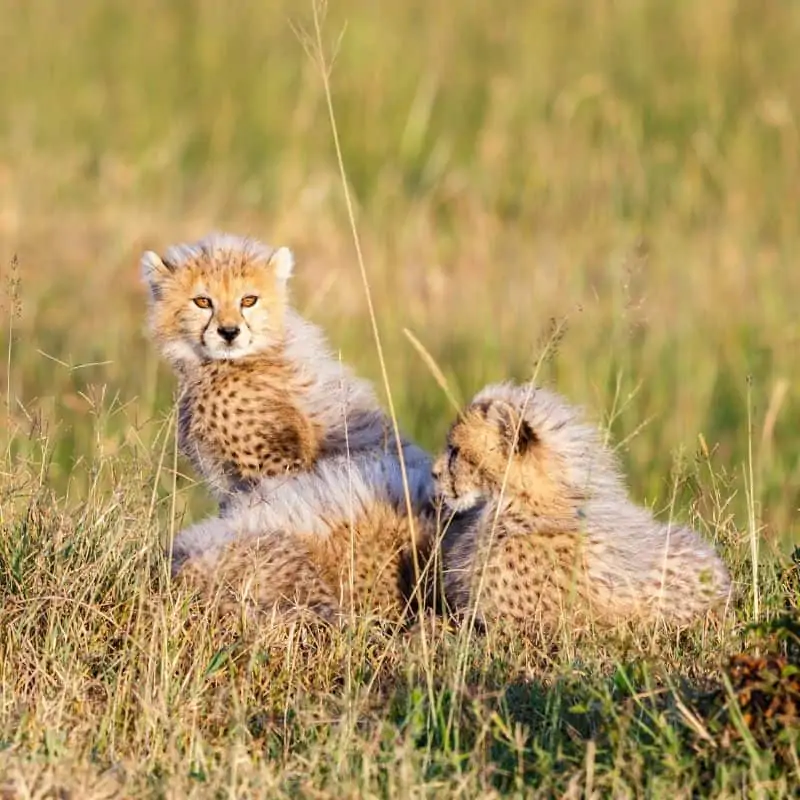
2. Cheetah cubs weigh less than 15 ounces
At birth, baby cheetahs weigh anywhere from 8.5 ounces to 15 ounces, while cheetahs in captivity weigh more since their mother always has access to food.
In addition, baby cubs are blind for the first 4-10 days and solely rely on their mother for help. However, after a day, the mother will leave to hunt for her new babies.
Since the cubs are left alone, it’s a difficult time for them, and they are susceptible to predators, including leopards and spotted hyenas. Unfortunately, in the wild, less than one in 10 cubs survive this period.
Humans also threaten cheetahs due to hunting, exotic pet trade, habitat loss, and illegal trafficking.
3. Cheetahs are born with 2500 spots
Baby cheetahs are born with distinguishable spots and roughly 2500 across their body. They also have a black fur strip under its eye, and it helps them camouflage from predators.
The marking, called a malar stripe or tear streak, goes from the tear duct to the mouth. Cheetahs also are born with all the spots they’ll ever have, and instead of developing new ones, their spots become larger and more spread out.
Baby cheetahs have thick fur, making them look similar to honey badgers, which aids in their survival. Honey badgers have few predators, which offers baby cheetahs a higher chance of survival.
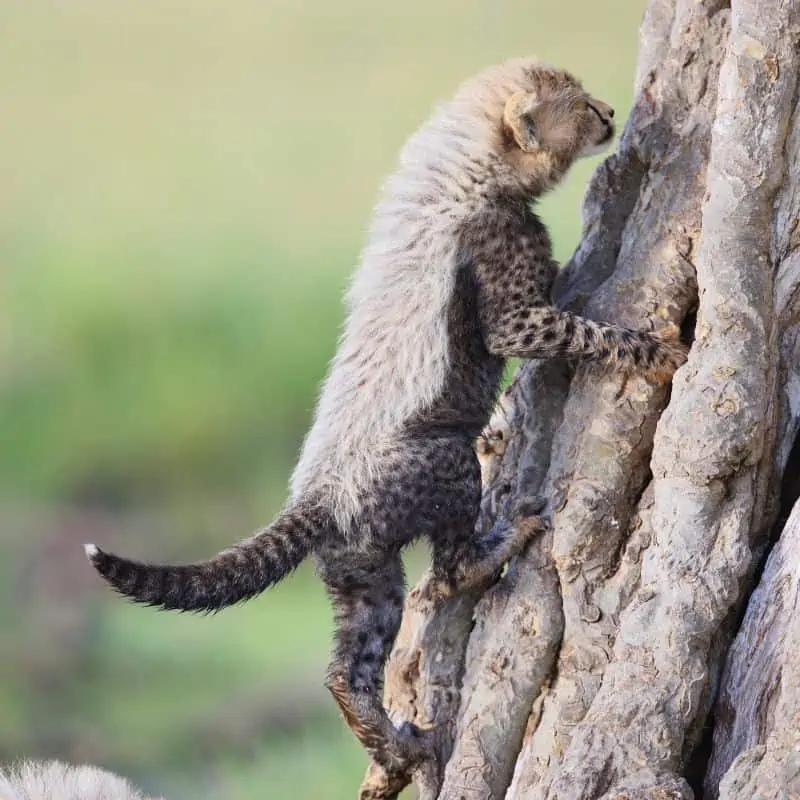
4. Baby cheetahs chirp and yelp
Part of the cute factor of baby cheetahs is the adorable sounds they make. Unlike other wild cats, cheetahs don’t roar and instead make different sounds, including:
- Purring
- Meowing
- Yelp
- Growl
- Chirp
- Moan
- Hiss
For example, a cheetah cub and its mother make a chirping sound with one another as a sign of contentment. Also, a baby cub will yelp if they are looking for its mother, which can be heard from over a mile away.
The purring of a cheetah sounds very similar to that of a domestic cat. Cheetahs have the same vocal box as domestic cats, which vibrate as they breathe in and out.
5. Cheetahs need two weeks to start walking
Unlike some animals, like giraffes or zebras, cheetahs cannot walk soon after birth.
Instead, cheetah cubs will begin walking when they are about two weeks old, so before then, they rely on their mother to move them around.
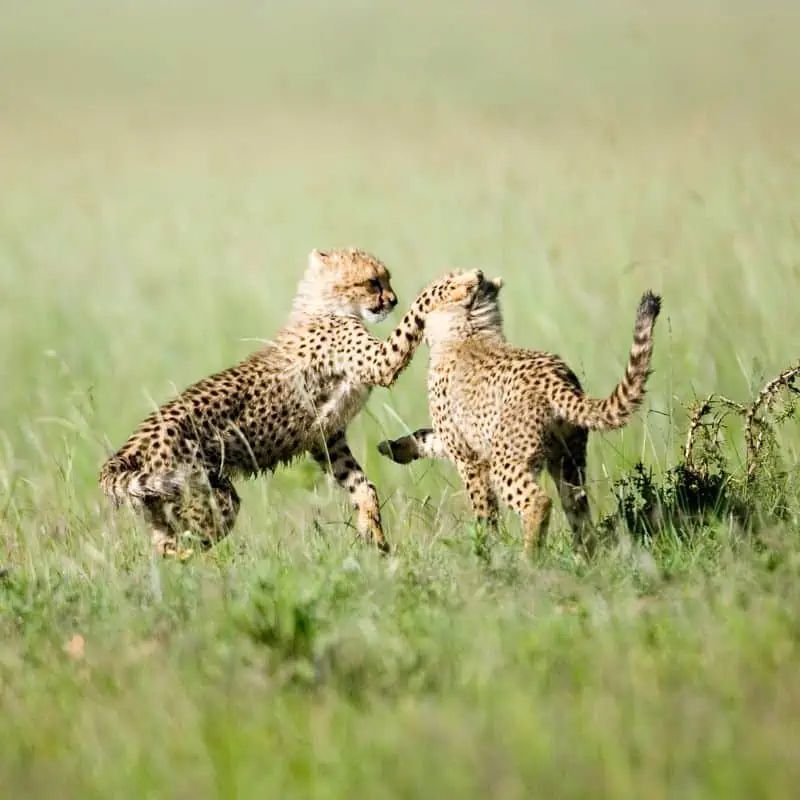
6. Baby cheetahs are very playful
Baby cheetahs are very playful and active, particularly after four months. Cubs will play with their siblings and are often seen chasing, pouncing, and wrestling. Cheetah cubs will even play and climb in trees, even though adult cheetahs rarely climb.
This is also an important time for cubs to learn how to hunt and catch prey.
So, while playtime is fun, they also must learn critical life skills to survive.
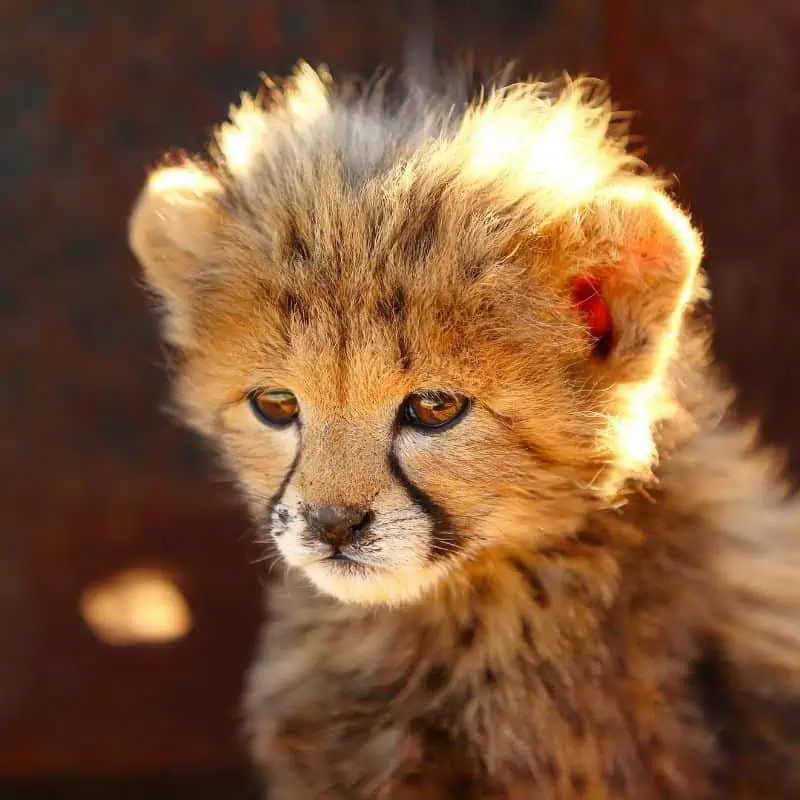
7. Short gestation period
On average, cheetahs are pregnant for 90-98 days and give birth in intervals of 17-20 months.
Usually, once cubs leave their mothers at 18 months of age, the mother will mate again.
Interestingly, cheetahs ovulate due to external factors, like a male in her presence.
8. Cheetahs stay with their mother until adolescence
Mothers keep their babies in a nest for the first 6-8 weeks; however, she continues to care for them for the first year and a half.
Mothers teach cubs how to hunt and keep them safe from predators during this time.
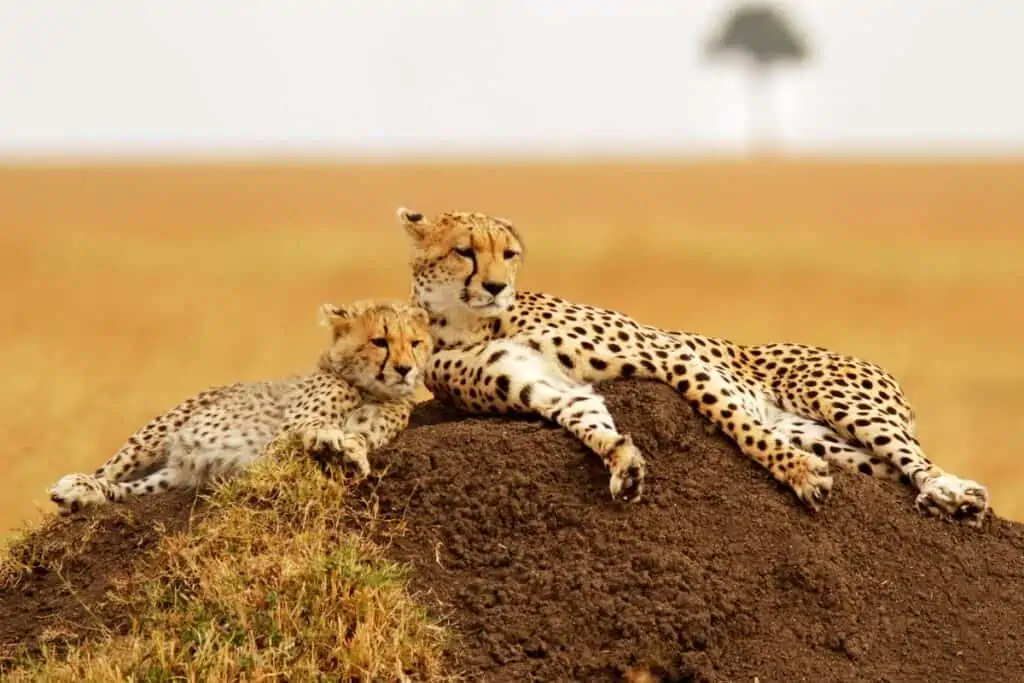
9. Cheetahs have between one and six cubs
A cheetah’s litter size can vary from one cub up to six. It is extremely rare for cheetahs to have more than six cubs, but it has happened.
Astonishingly, the largest cheetah litter ever birthed was eight cubs in a conservation center in Connecticut. The mother was a King cheetah, appropriately named Mona Lisa.
One of the cubs was named Adaeze, meaning “daughter of a king”, while another, following a media contest, was named “Machozi!” which is Swahili for “tears”. Another appropriate name for the iconic tear marks on the cheetah face.
10. Baby cheetahs are gradually introduced to meat
Baby cheetahs will live off their mother’s milk for the first three months before they begin learning important life skills like hunting.
Occasionally, a young cub might try meat before a month old; however, it is gradually introduced.
11. King cheetah cubs are extremely rare
King cheetahs and their cubs are incredibly rare and have several distinctive features from regular cheetahs, including their unique stripes, which are considered by many as a genetic mutations.
Their spots are irregular in pattern, opposite that of traditional cheetah spots.
So, what are the chances you’d ever see one in the wild? Not very high, unfortunately.
According to the African Wildlife Foundation, less than ten live in the wild throughout South Africa and Zimbabwe. However, various wildlife reservations and protected parks house a combined 30-50 king cheetahs.
Final thoughts on the baby cheetah
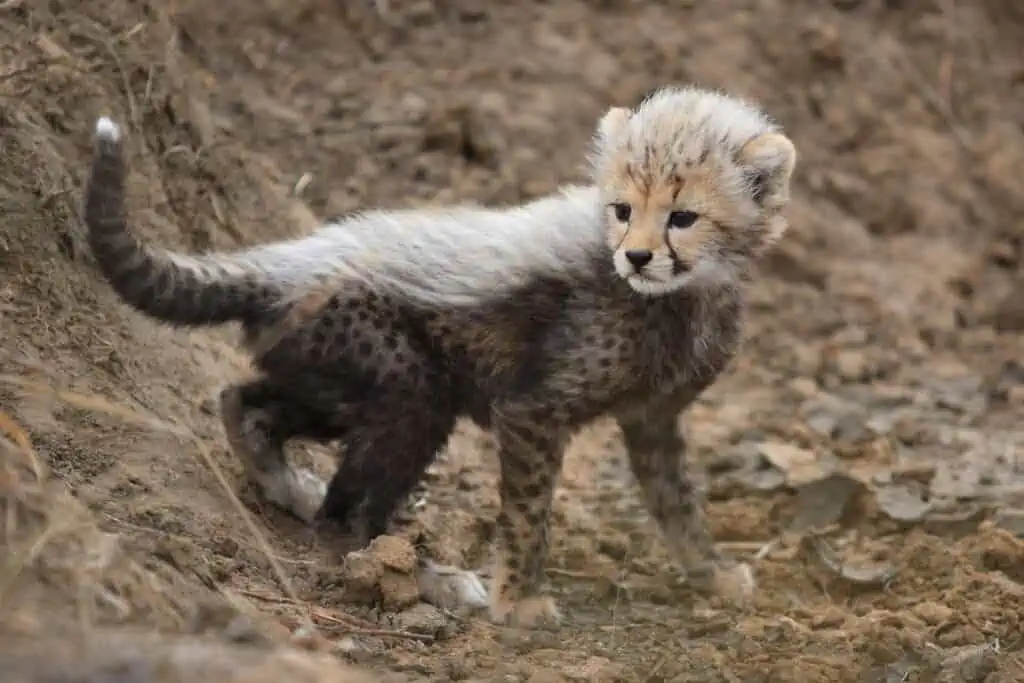
The baby cheetah is a fascinating animal with many unique features.
They are born with several markings that make them easily identifiable, and they grow to be speedy hunters.
Even though they are playful as cubs, they also must learn the skills necessary to survive in the wild.
While their chances of survival in the wild are low, their mothers teach them everything they need to know to make it on their own.
